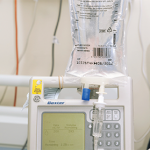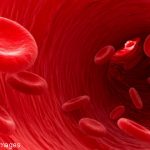Relapse Risk Factors
Among all patients, those with antiproteinase3 (PR3) ANCA antibodies were at an increased risk of relapse compared with those with anti-myeloperoxidase (MPO) ANCA or no ANCA antibodies, investigators found (hazard ratio [HR]=2.18; P=0.012).
Researchers found ANCA status and B cell counts to be telling. In the azathioprine group, researchers found 22 of the 27 patients were ANCA positive at relapse. In the rituximab group, none of the three patients who suffered a major relapse before Month 28 had CD19 B cell reconstitution, but two of them were ANCA positive at relapse. But after that, 12 of the 13 with a major relapse were ANCA positive at relapse, and they all showed CD19 B cell reconstitution.
“Patients with PR3-ANCA at baseline and with ANCA that remain or become positive during follow-up are at high risk of relapse,” Dr. Terrier says. He said no data are yet available to guide clinicians on whether these patients should be treated for the same duration as other patients and simply be closely monitored, or whether they should be treated for a longer period of time than patients who remain negative for PR3-ANCA.
“Overall, the main concern from these results is clearly the need to better identify patients with high-relapse risk [who] could benefit from longer treatment, and efforts are currently being made to optimize treatment strategy,” he says.
These efforts are now underway. In the United Kingdom, in the rituximab vs. azathioprine as therapy for maintenance of remission for anti-neutrophil cytoplasm antibody-associated vasculitis (RITAZAREM) trial, researchers are evaluating the efficacy of a higher rituximab dose—1 g every four months over 20 months—compared with azathioprine. And in MAINRITSAN3, investigators are looking at the benefit-to-risk ratio of continuing rituximab for 18 more months than the duration used in MAINRITSAN.
Dr. Dua says the relapses seen in each group were not necessarily surprising, with those in the azathioprine group beginning to relapse in the first year after drug discontinuation and rituximab patients starting to experience major relapse 18–24 months after the last infusion. She says it is also important to note the rituximab-treated patients who suffered major relapses saw reconstitution of their B cells at the time of relapse.
“Of course, it would be wonderful to see the rituximab group stay relapse free throughout the length of this follow-up—60 months,” she says. “However, the results reflect the mechanisms of action of the drugs used.”
Questions still facing researchers and clinicians include whether higher doses of rituximab would be just as safe but more effective, whether the duration of rituximab treatment should be lengthened and whether such markers as seroconversion, ANCA titers and B cell population could signal windows of opportunity to redose or increase dosage for longer relapse-free periods. Upcoming studies could help answer these questions, Dr. Dua says.
“Other questions not specific to rituximab dosing include whether low doses of prednisone—even though we are trying to minimize steroid exposure—might enable select patients to stay in remission longer,” she says. “Are there other biomarkers that can help us identify disease earlier, or features—genetic, clinical, serologic, pathologic or otherwise—specific to patients that can help us to identify the precise medication that will be most effective and best tolerated for a specific patient?”

